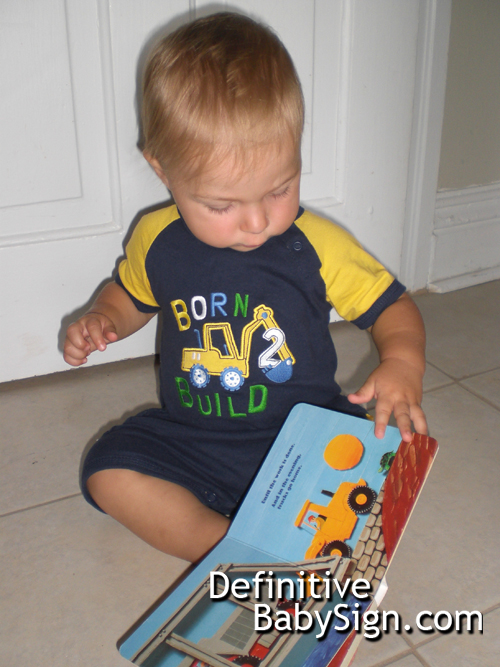 We acquired a new book for our son second hand. It was a cartoon filled book about as tall as he was and double his width. Needless to say, there was a lot of things going on, on each page. Since it was new, he and I had spent some time, but not a lot going over the various names for things verbally as he pointed them out.
We acquired a new book for our son second hand. It was a cartoon filled book about as tall as he was and double his width. Needless to say, there was a lot of things going on, on each page. Since it was new, he and I had spent some time, but not a lot going over the various names for things verbally as he pointed them out.
My wife was in the other room and our son pointed one by one, fire truck, ambulance, I called them out. Then he pointed to an image and began signing. His index and middle finger touched the inside of his palm repeatedly. I was confused, so I did my best and said “fall down?” At this our baby signed again, then I asked him for help and told him to point to what he meant. He pointed at an abstract image again and did the sign which appeared the same as before. I said to him that I had no idea what he was signing and he got frustrated like I’ve never seen him get before. I thought to myself that this is what other parents that don’t have signing babies must feel all the time! He then pointed again, this time it was more clear, he was pointing at a character doing a painting. So I said “Painting?” and he signed in relief and moved onto the next image. That was the sign for painting I guess! My wife chirped in from the other room “Oh, I taught him that the other day!” Mystery solved!
I couldn’t help but wonder what a child without sign does in such situations. I supposed it might unfold somewhat similarly. As you blurted out labels for the things they pointed at they’d be comforted but only so long as they matched their mental recollection of the images. This is no different than a signing baby. What a non-signing toddler lacks though, is the ability to call out labels on their own – they rely on their parents and caregivers to do it for them. Both signing and non-signing babies can point and grunt at things, you can guess, and then they can try to correct you. But when signs are involved, they’re mixed in with the grunting and general annoyance a baby feels from being misunderstood. However, when both parent and child know the signs, they come to a faster mutual understanding. This gives a baby both power – to influence other people’s thoughts – and the confidence that this skill brings. This is likely why babies who sign have so much higher self esteem, they are used to being an active member of their families. They can talk to other people about the things that are on their minds, they don’t have to wait for other people to bring these subjects up for them. They can also do these things from the earliest moment possible so long as they are taught to sign at around 9-11 months, and don’t “suffer” from the frustration of being “muted.”
Signs give baby an early voice.
